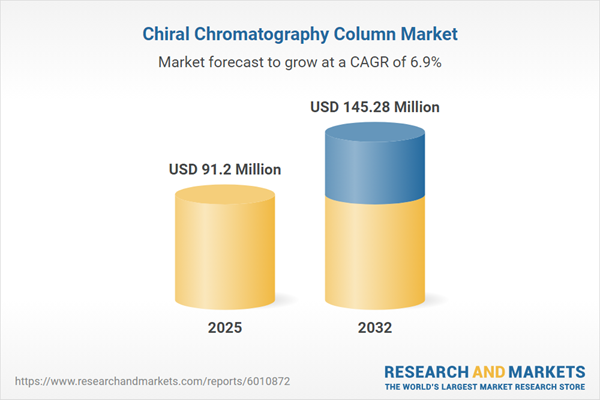Speak directly to the analyst to clarify any post sales queries you may have.
Chiral chromatography columns are essential to reliable laboratory analysis and compliance-driven environments. For senior decision-makers, these columns provide a direct pathway to enhanced data quality, regulatory alignment, and streamlined operations, forming a critical component of modern laboratory infrastructure.
Market Snapshot: Global Chiral Chromatography Column Market Size and Growth
The chiral chromatography column market continues its robust expansion, with the global market valued at USD 85.26 million in 2024 and projected to reach USD 91.20 million in 2025 before advancing to USD 145.28 million by 2032. This trajectory corresponds to a compound annual growth rate (CAGR) of 6.88%. Key factors include ongoing pharmaceutical research and development, advancements within agrochemical processing, and intensifying food safety oversight. Regulatory standards prioritizing sustainability, accurate test outcomes, and operational compliance set the competitive landscape as laboratory modernization accelerates. As evolving regulations and analytical requirements intensify, chiral chromatography columns are vital for sectors where quality, safety, and repeatability define business performance.
Scope & Segmentation of the Chiral Chromatography Column Market
- Column Types: Crown ether, cyclodextrin, macrocyclic antibiotic, Pirkle type, polysaccharide-based, and protein-based columns address specific needs in research, industrial quality control, and regulated testing environments.
- Key Polysaccharide Derivatives: Amylose tris(3,5-dichlorophenylcarbamate) and amylose tris(3,5-dimethylphenylcarbamate) derivatives, as well as cellulose-based counterparts, suit laboratories requiring precise and reproducible separations under regulatory scrutiny.
- Technologies: High-performance liquid chromatography (HPLC), ultra-high-performance liquid chromatography (UHPLC), and supercritical fluid chromatography (SFC) ensure sensitive, high-throughput, and dependable separations across various sectors.
- Applications: Support pharmaceutical R&D, agrochemical validation, food safety monitoring, environmental analysis, and academic research, reflecting the need for compliance, reproducibility, and method modernization.
- End Users: Pharmaceuticals, biotechnology companies, research institutes, food manufacturers, environmental laboratories, and agrochemical firms drive demand for accurate test results and validated data.
- Modes of Operation: Analytical and preparative configurations facilitate adaptation from initial method development to scaled purification in diverse operational settings.
- Particle Sizes: Sub-2 micron, 2–5 micron, and above 5 micron formats allow flexible optimization for speed, resolution, and sensitivity based on specific analytical needs.
- Regions: The Americas, Europe, Middle East, Africa, and Asia-Pacific each exhibit distinct trends driven by local regulation and laboratory infrastructure, impacting procurement approaches and adoption rates.
- Key Companies: Major market participants, including Daicel Corporation, Thermo Fisher Scientific Inc., Agilent Technologies Inc., Waters Corporation, Merck KGaA, Shimadzu Corporation, Danaher Corporation, JASCO Corporation, Restek Corporation, and Regis Technologies Inc., offer specialized product lines and global support to meet industry standards.
Key Takeaways for Senior Decision-Makers
- Chiral chromatography columns underpin consistent quality assurance frameworks and regulatory compliance across industries where test reliability is paramount.
- Innovations in stationary phase materials broaden practical applications and enhance support for advancing research objectives and regulatory mandates.
- Laboratories are shifting toward sustainability by employing columns and methodologies that lower overall solvent use, aligning operations with environmental goals.
- Supply-side partnerships and collaborations with researchers accelerate laboratory automation, ensuring agility in response to evolving operational requirements.
- Procurement priorities reflect regional market maturity, with mature markets focusing on integration while emerging regions emphasize rapid capacity expansion and versatile supply chains.
- Comprehensive vendor solutions in risk management and procurement reinforce organizational resilience, addressing dynamic shifts in the commercial and regulatory environment.
Tariff Impact: Navigating Supply Chain Change
With new U.S. tariffs anticipated in 2025, sector participants are reassessing procurement, sourcing, and logistics strategies. Senior leaders are bolstering regional distribution and reinforcing operational supply chains to preserve stable pricing and minimize disruptions amid shifting international trade dynamics.
Methodology & Data Sources
This report draws on in-depth interviews with sector experts, reviews of technical publications, and procurement-focused whitepapers. Multi-source verification processes ensure that the insights provided are actionable and reliable within complex regulatory and operational landscapes.
Why This Report Matters for Decision-Makers
- Enables procurement and investment teams to adapt sourcing and purchasing strategies in line with overall corporate objectives and market shifts.
- Provides quality management and operations leaders with up-to-date guidance to strengthen compliance, promote sustainability, and increase workflow efficiency.
- Equips organizations to navigate regulatory and market volatility, ensuring continuity in laboratory and supply processes for strategic planning purposes.
Conclusion
Chiral chromatography columns remain fundamental to laboratory accuracy and regulatory preparedness. Strategic attention in procurement and operational planning positions organizations to adapt as the industry landscape evolves.
Additional Product Information:
- Purchase of this report includes 1 year online access with quarterly updates.
- This report can be updated on request. Please contact our Customer Experience team using the Ask a Question widget on our website.
Table of Contents
3. Executive Summary
4. Market Overview
7. Cumulative Impact of Artificial Intelligence 2025
Companies Mentioned
The companies profiled in this Chiral Chromatography Column market report include:- Daicel Corporation
- Thermo Fisher Scientific Inc.
- Agilent Technologies, Inc.
- Waters Corporation
- Merck KGaA
- Shimadzu Corporation
- Danaher Corporation
- JASCO Corporation
- Restek Corporation
- Regis Technologies, Inc.
Table Information
| Report Attribute | Details |
|---|---|
| No. of Pages | 187 |
| Published | November 2025 |
| Forecast Period | 2025 - 2032 |
| Estimated Market Value ( USD | $ 91.2 Million |
| Forecasted Market Value ( USD | $ 145.28 Million |
| Compound Annual Growth Rate | 6.8% |
| Regions Covered | Global |
| No. of Companies Mentioned | 11 |









